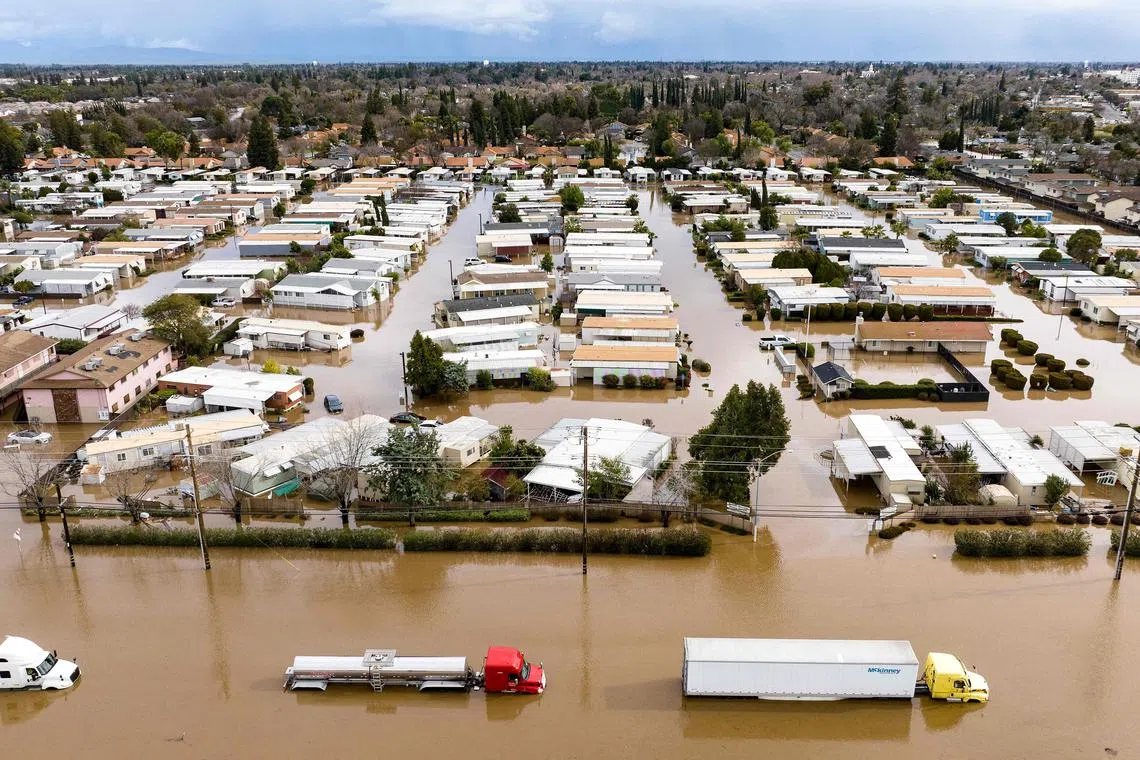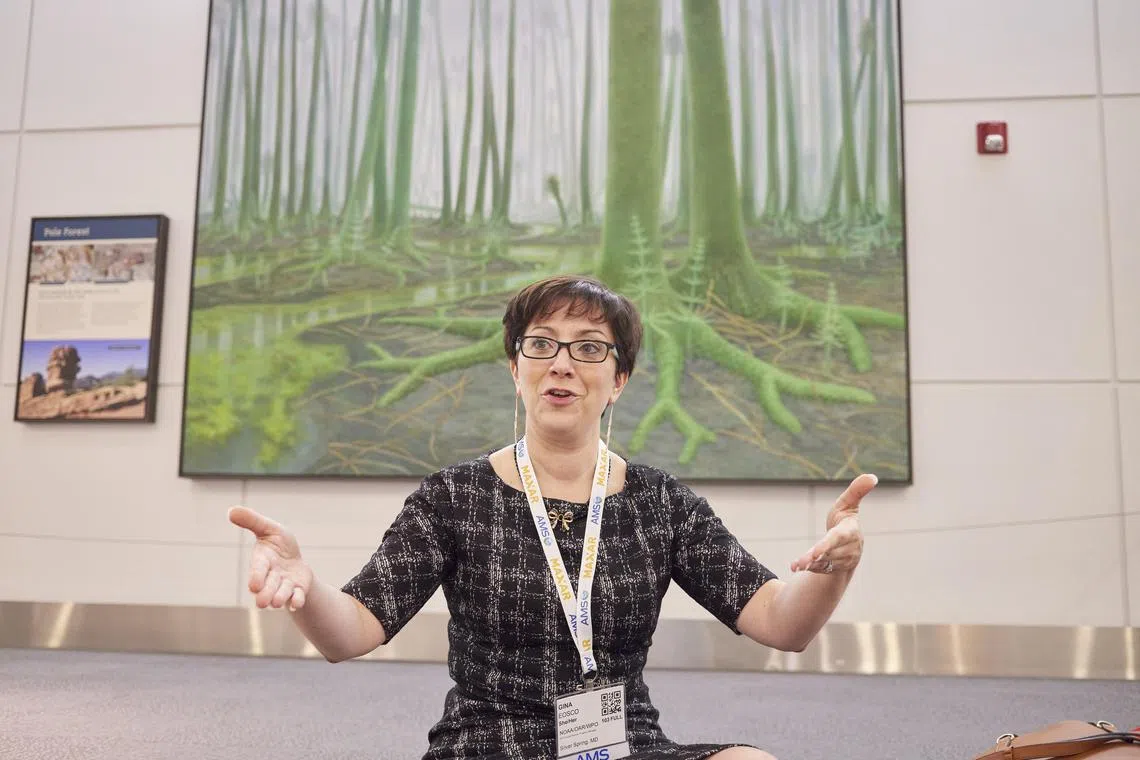Bomb cyclone? Or just windy with a chance of hyperbole?
Sign up now: Get ST's newsletters delivered to your inbox

A flooded neighborhood in Merced, California on Jan 10, 2023.
PHOTO: AFP
Follow topic:
DENVER – Last week, days after a bomb cyclone (coupled with a series of atmospheric rivers,
Scores of the world’s most authoritative meteorologists and weather scientists gathered to share the latest research at the 103rd meeting of the American Meteorological Society. The subject line of an email to participants on the first day projected optimism – “Daily Forecast: A Flood of Scientific Knowledge.”
But there were troubling undercurrents. Scientists are in consensus on the increasing frequency of extreme weather events – the blizzard in Buffalo, New York, flooding in Montecito, California, prolonged drought in East Africa – and their worrisome effects. At the Denver meeting, however, there was another growing worry: how people talk about the weather.
The widespread use of colourful terms like “bomb cyclone” and “atmospheric river,” along with the proliferating categories, colours and names of storms and weather patterns, has struck meteorologists as a mixed blessing: good for public safety and climate-change awareness but potentially so amplified that it leaves the public numb to or unsure of the actual risk. The new vocabulary, devised in many cases by the weather-science community, threatens to spin out of control.
“The language evolved to get people’s attention,” said Cindy Bruyere, director of the Capacity Center for Climate and Weather Extremes at the National Center for Atmospheric Research. She sat with two fellow scientists at a coffee bar between sessions and became increasingly animated as she discussed what she called “buzz words” that lack meaning.
“I have zero pictures in my head when I hear the term ‘bomb cyclone,’” she said. “We need significantly clearer language, not hyped words.”
Others find that the words, while evocative, are sometimes used incorrectly.
“The worst is ‘polar vortex,’” said Andrea Lopez Lang, an atmospheric scientist at the State University of New York in Albany, as she stood in a corridor between weather-science sessions. Lopez Lang is an expert in polar vortices, which technically are stratospheric phenomena that occur at least 10km above sea level. “But in the last decade, people are starting to describe it as cold air on the ground level,” she said.
In an effort to contain the runaway verbiage, weather scientists have begun to study the effect of extreme-weather language. How do people react to the way the weather is communicated? Do they take the proper precautions? Or do they tune it out?
It’s “a hot topic,” said Gina Eosco, a social scientist with the Weather Program Office at the National Oceanic and Atmospheric Administration. “Literally, communication is our No. 1 concern.”
In 2021, Eosco was an author of a paper with the less-than-pithy title, “Is a Consistent Message Achievable?: Defining ‘Message Consistency’ for Weather Enterprise Researchers and Practitioners.”
For the moment, the answer to the paper’s question is: cloudy. To underscore the issue, Eosco – sitting on the floor in one conference hall – pulled out her phone and showed a collection of messages from various television stations and websites that used competing graphics, colours and language to characterise the tropical storm Henri, in 2021. The presentations were not terribly distinct from one another, Eosco noted, but they hinted at the diversity in approaches to branding intense weather.
“I’m trying to see how are people designing it this year,” she said. “They’re giving it a face-lift, essentially.”
To fully understand the effect of how people talk about weather, Eosco said, more information is needed. Her division of NOAA has put out calls for researchers to quantify the effectiveness of weather-messaging strategies, including “visual, verbal messages, naming, categories.”
The broader aim, she said, was to make sure that the official cascade of weather terminology promoted understanding and an appropriate response from the public, not confusion.
“I got a text from a family member this weekend that said, ‘Is an atmospheric river a real thing?’” said Castle Williams, a social scientist sitting on the floor beside Eosco; the two were joint authors on the 2021 paper about consistent weather messaging. “She thought it was a made-up word for intense rainfall.”
Eosco noted that researchers were exploring whether to group atmospheric rivers into categories, much as hurricanes were ranked numerically according to severity.
Some of the vivid terminology begins with the scientists – “bomb cyclone,” for instance. “The reason we called it a bomb is because it is the explosive intensification of a surface cyclone, in other words, the winds you are experiencing near the ground where people live,” said John Gyakum, a meteorologist at McGill University who helped coin the term in the 1980s. The less-pithy definition is “a 24-hour period in which the central pressure falls by at least 24 millibars,” which is a measure of atmospheric pressure.
“Why do we hear more about bomb cyclones than we did 40 years ago?” he said. “People are paying more attention to extreme weather than in the olden days.” He added, “Talking about bomb cyclones is not necessarily an indication of increased frequency.”

Gina Eosco, a National Oceanic and Atmospheric Administration social scientist, at the American Meteorological Society’s annual conference in Denver, on Jan 9, 2023.
PHOTO: NYTIMES
According to Google Trends, the phrase “bomb cyclone” was barely uttered until 2017 but has since has risen to a din, along with “weather bomb” and “weather cyclone bomb.”
Some meteorologists said they had become cautious about what they uttered, to avoid sensationalism. “Once you use a term and let the cat out of the bag, you can’t get it back in,” said Andrew Hoell, a research meteorologist with NOAA, where he is co-leader of the drought task force. “It can be used in ways you never imagined.”
In the end, the linguistic dilemma reflects a larger challenge. On one hand, scientists say, it is hard to overstate the profound risk that global warming poses to Earth’s inhabitants in the next century and beyond. But the drumbeat of language may not be appropriate for the day-to-day nature of many weather events.
Blame is typically cast in the passive voice: Weather scientists crafted attention-grabbing terms, which were drawn into the ratings-driven media vortex. Daniel Swain, a climate scientist at UCLA, said the technical terminology was widely used without context by traditional news media and on social media “where some people might use a term half-jokingly and others are genuinely freaking out.”
He added, “Headlines literally sound like the end of the world.” NYTIMES

